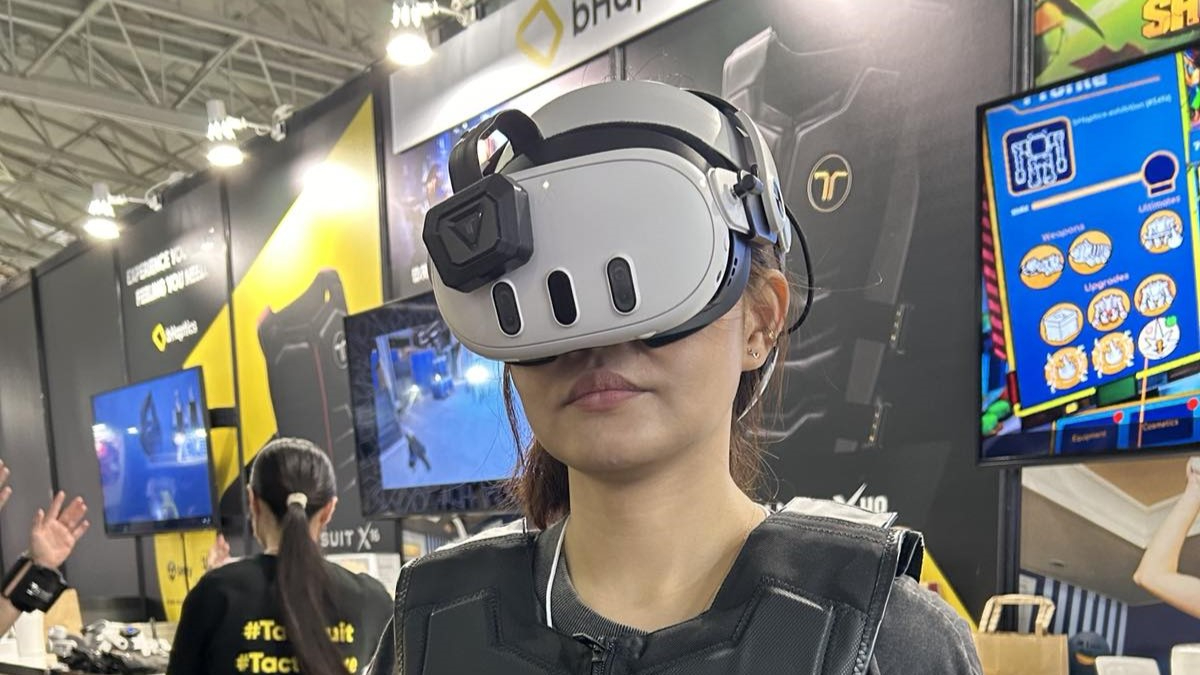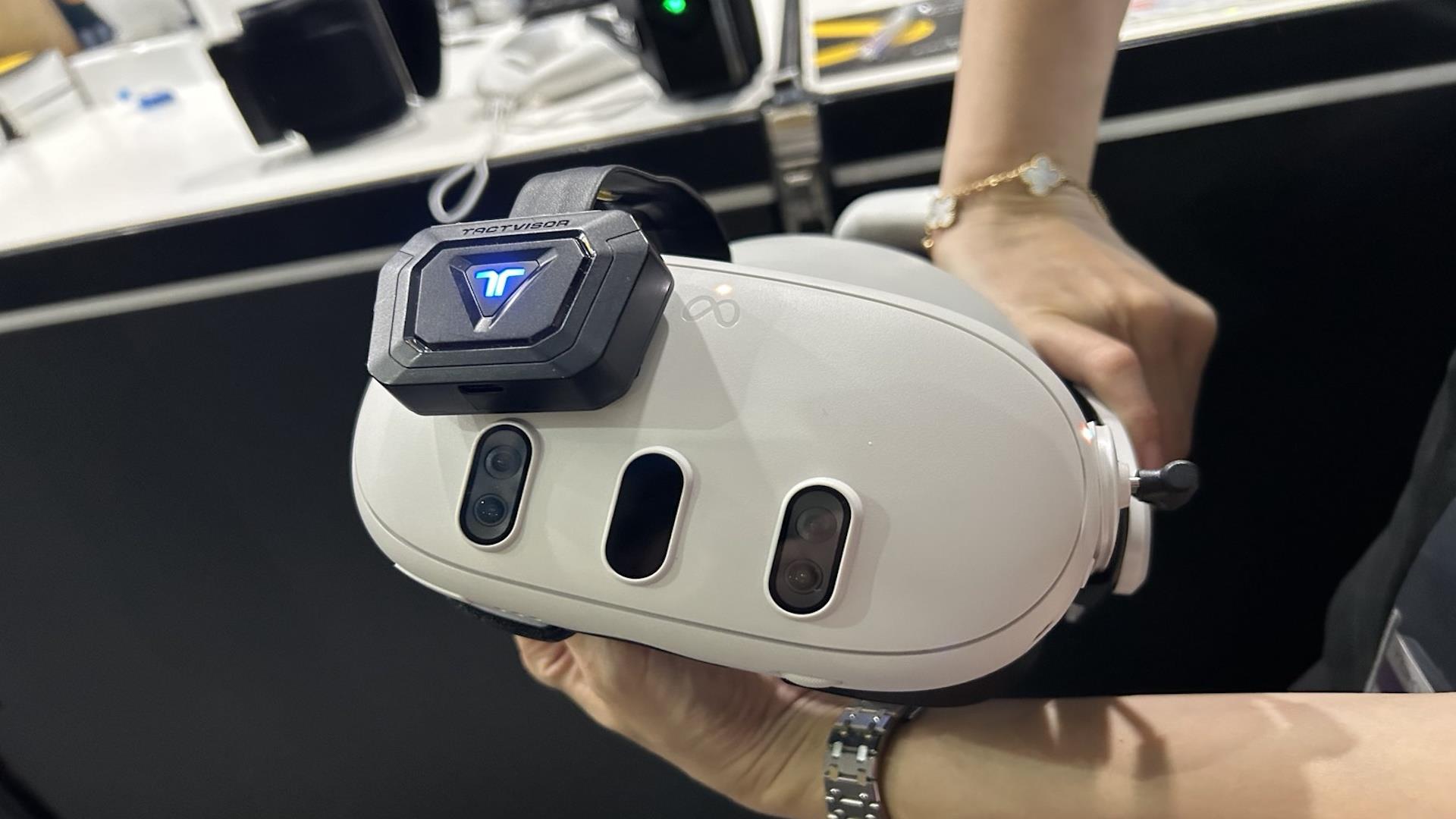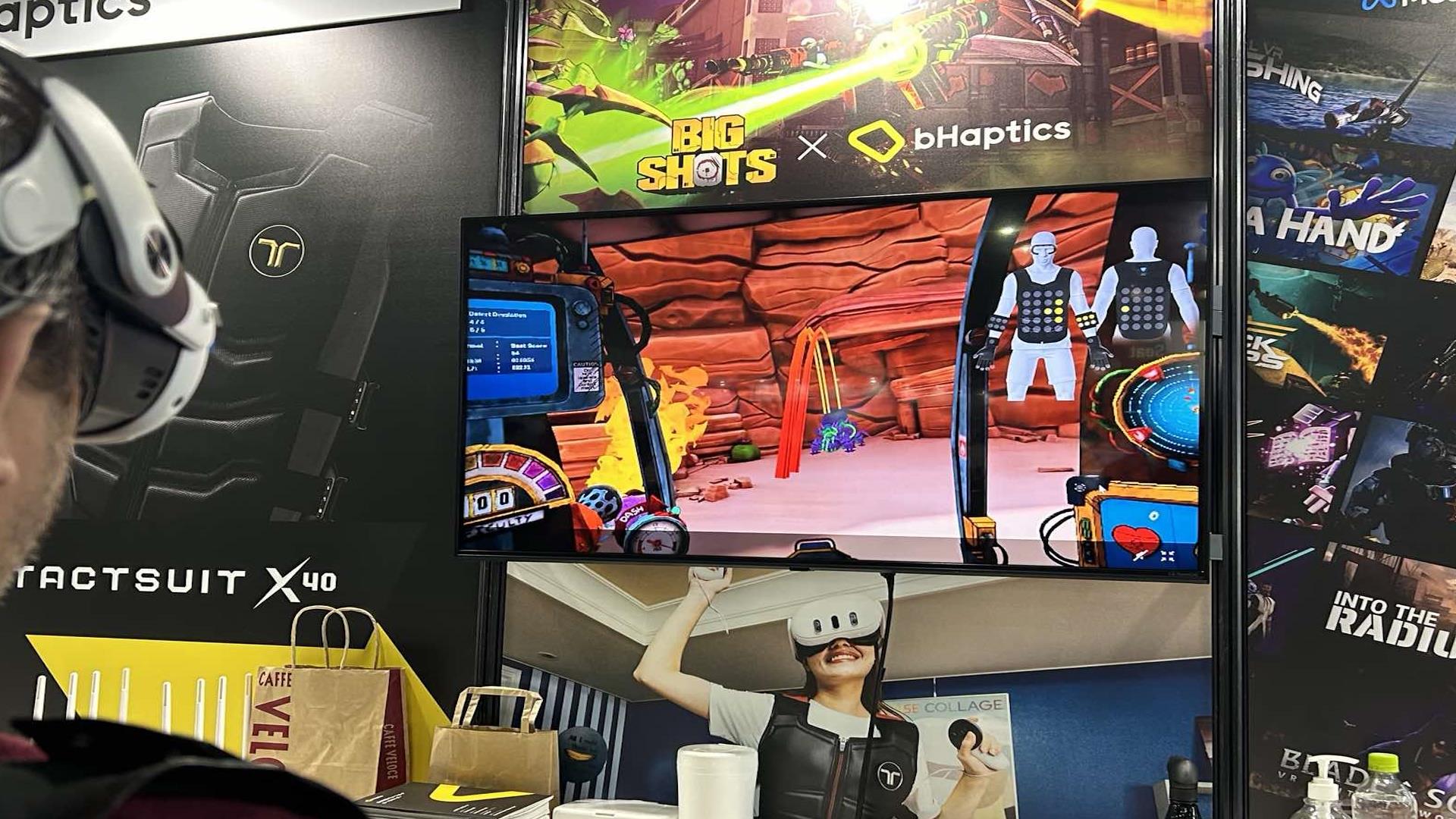Piloting a mech in VR while wearing a bHaptics suit showed that full-body haptic immersion might not be that far off
Feel the rumble

bHaptics, a tech and hardware development company based in South Korea, specializes in suits, accessories, and gadgets that provide haptic feedback. I had the opportunity to try a few of their products during the Tokyo Game Show: the TactSuit X40, Tactosy for Arms, and TactVisor.
I also spoke with bHaptics representative Jieun Jeon, who touts this full complement of devices as the company’s most immersive package yet, one that creates seamless and realistic haptic feedback based on a variety of situations in-game. With these peripherals, I’d feel every shot, reload, punch, kick, or explosion, as though I was right in the middle of the action.
Feel every detail

The aforementioned TactSuit X40 has 40 haptic feedback points spread along its mesh lining and interior at the front, back, and sides. This is a huge improvement compared to their previous release, the TactSuit x16 which only has 16 vibro-tactile motors. The Tactosy for Arms, meanwhile, has six haptic feedback points on each device. Lastly, the TactVisor fits perfectly on a VR headset, almost akin to a silicone face cover.
Each feedback point mimics the sense of touch or physical impact. The intensity and frequency of vibrations are increased the more points there are, along with dynamic applications depending on the body part that receives said feedback. For instance, taking a punch to your ribs during a VR boxing match would cause a rumbling effect on that portion of the vest; the same can be said for the arm sleeves if you land a hit against an opponent.
Jeon claims that the company offers compatibility support for over 250 VR games, from blockbusters like Half-Life: Alyx and The Elder Scrolls V: Skyrim VR to multiplayer shooters like Pavlov VR and quirky indie titles like Tiny Archers.
As part of the Tokyo Game Show demo, I was able to try the devices while playing Big Shots, a mecha action game from developer AlterEyes. The feedback from bHaptics’ peripherals was in full effect as soon as the first wave of enemies spawned. As I scorched alien foes using the flamethrower mounted on my robot’s right arm, the Tactosy on my right wrist also started rumbling. The vibrations continued to intensify for several seconds as I blasted my targets.
Then, whenever the giant bugs managed to claw at my mech, I’d feel the impact on my upper chest and lower back in the exact spots where enemies hit me. Likewise, during instances when multiple hostiles jumped toward me at the same time, I could feel those forceful pounces through the TactSuit vest, as though I was being swarmed in real life.
Sign up for breaking news, reviews, opinion, top tech deals, and more.
Moreover, I felt a bit of tingling on my forehead from the TactVisor, primarily when explosions occurred near the mech that I was piloting or when I jumped and landed hard on the ground, akin to an aftershock effect. To top it all off, an overlay on the screen also showed which feedback points were vibrating in real-time.
The experience–which was something of an all-out barrage, I felt every weapon blast and critical blow which greatly impressed me. However, a part of me also would’ve preferred a demo that could showcase haptic feedback from every spectrum though, from the most intense and impactful strikes to lighter beats and irregular rumbling, such as footsteps, heartbeats, or the pitter-patter of raindrops.
Haptic feedback outside of VR

It’s worth mentioning that bHaptics creates software and software development kits (SDKs) to make haptic integration easier for developers. The company collaborates regularly with development teams to facilitate native support for certain titles too. This has made several of bHaptics’ products compatible with a number of the best VR headsets, most notably the entire Meta Quest series and PSVR 2.
Aside from this, 3rd-party developers and users of haptic suits can create and distribute their own mods and presets; bHaptics generates links on their website so consumers can readily find the mods that they need.
It's also possible to connect the TactSuit X16 or X40 vest with a PC, console, or mobile phone. This allows you to make use of the vest’s audio-based haptics feature so you can still feel the tactile effects, whether you’re playing a flatscreen game, streaming a show, or listening to music—the vest’s functionality isn’t just for VR titles. Moreover, the bHaptics Player app lets you create Audio-to-Haptics profiles as presets for the type of media or content that you enjoy.
At the end of the demo, I asked Jeon about her recommendations in case I had a tight budget. She initially suggested the TactSuit X16, which costs $329 (approximately €298 or ₤250). This was, admittedly, a pretty steep price, especially for one of their older products. However, those who are able to splurge might be interested in the FPS Bundle - which includes the more advanced TactSuit X40 and the Tactosy for Arms - which costs $659 (approximately €598 or ₤502).
bHaptics’ devices aren’t budget-friendly, to say the least - that almost costs as much as a PS5 Pro pre-order. Nevertheless, I came away feeling like these devices and peripherals offer unparalleled immersion for gamers who want to experience the next level of advanced haptic feedback technology.
Now I’m just hoping that they’d make a 5XL vest because that TactSuit was quite a tight fit for a more “horizontally challenged” person like myself...
You might also like...
- Silent Hill 2 review: a stylish remake, but not definitive
- If you just pre-ordered the PS5 Pro, don't miss these huge savings on six enhanced games
- Lexar Play 2280 review: really needs a price cut
Jason Rodriguez is a freelance writer from the Philippines. He started covering games in 2018. Since then, he's freelanced for a number of outlets, including GameSpot, Digital Trends, PCGamesN, Game Informer, and the Epic Games Store. Jason predominantly focuses on game guides and reviews, and he has over 6,000 published articles. If he's not busy with work, he and his wife are likely hunting for anime figures to add to their collection, or they're probably looking for a new cat to adopt.
